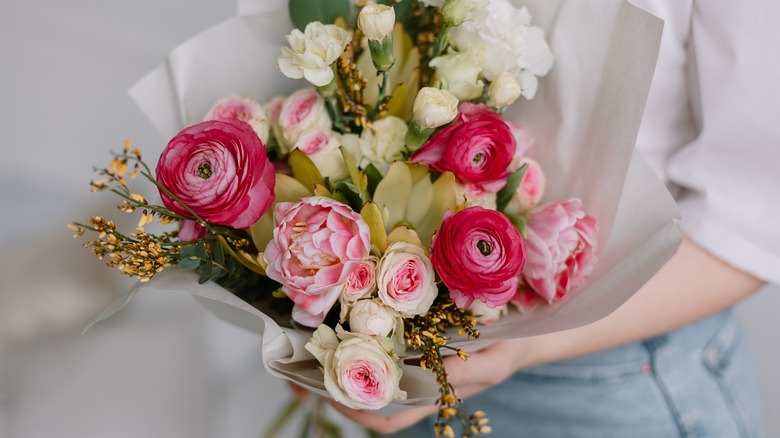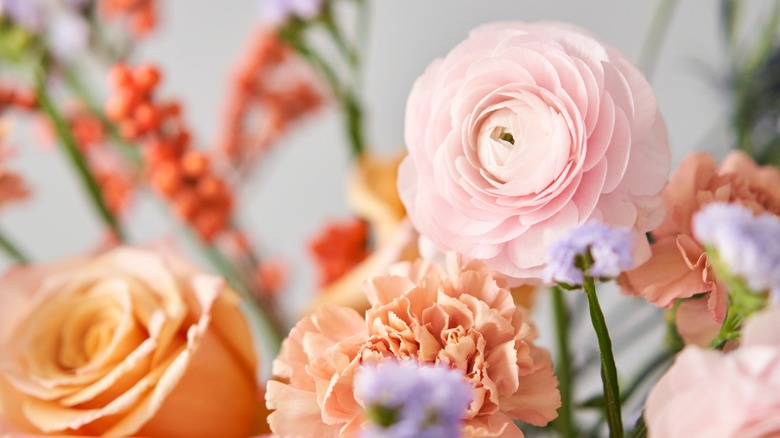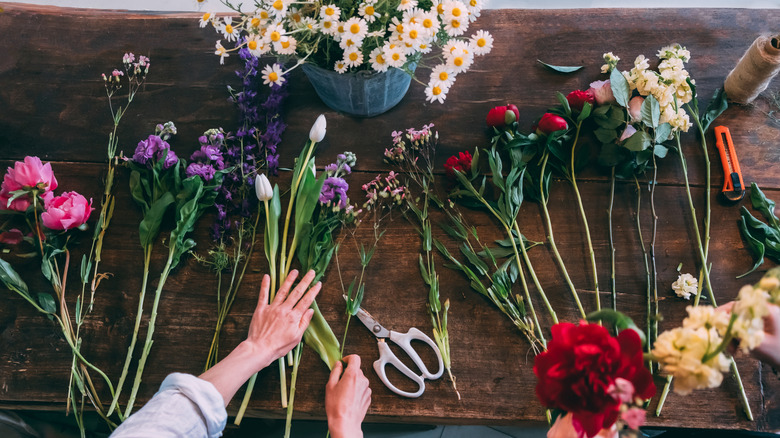Joanna Gaines Gives Her Best Tips On How To Style The Perfect Flower Arrangement
Nothing brightens up a room like a vase full of fresh flowers. A beautiful arrangement of blooms can add plenty of color and texture, creating visual interest and personality in the space. Whether buying flowers from the grocery store or picking them from your garden, Joanna Gaines has an approach to creating a picture-perfect arrangement. Scrolling through her social media, Gaines is no stranger to growing or arranging stunning blooms. The garden on her farm is filled with colorful dahlias, snapdragons, and tulips, among many other plants and flowers.
She regularly cuts flowers to create arrangements for her home and, in doing so, creates a bouquet that ranges in color and texture. Without much finagling, Gaines explains how the flowers pair together well naturally, which gives the bouquet a wild, fresh-from-the-garden look. "They all play so well together," Gaines said on Instagram. "The dahlias, how structured and prominent that they are. I think the orlaya makes it a little more whimsical and not so structured ... The waxflowers bring in that structure but in a smaller form. The Queen Anne's lace and the orlaya also bring height to the arrangement ... Scabiosa brings that depth of color."
Art of flower arranging
Joanna Gaines believes in allowing nature to work its own magic (via Instagram). However, there is an art to flower arranging that can help serve as the base for creating the perfect centerpiece bouquet. Gaines, for example, talks about the structure and height that certain flowers bring to her arrangement. This, as well as color, form, texture, spacing, and line, correspond with the elements of floral design, while balance, dominance, contrast, proportion, scale, rhythm, and harmony are the principles. Keeping these in mind as you're choosing and arranging flowers can ensure a bouquet looks good no matter what.
Line creates the shape and structure of the arrangement, which has to do with details like the petals, stems, and leaves. All of these create lines that the eyes follow through the bouquet. Color is the next most important element, as that is what creates the harmony and beauty of the arrangement. You can decide upon various hues for flowers by using the color wheel. There are various types of color schemes to create the theme of the arrangement.
Choosing flowers
Once you understand the elements of flower arranging, you can start choosing what you'd like to include. As Joanna Gaines said, you don't have to put a ton of thought into making your arrangements perfect (via Instagram). However, understanding what different flowers bring to an arrangement can also make you feel confident in your choices. Larger flowers like dahlias, as Gaines uses, as well as garden roses and peonies, tend to pull focus, so they help to anchor the design. Flowers with longer lines, like delphiniums and foxgloves, add dimension.
Use smaller blooms to create filler, such as the waxflowers Gaines chose for her arrangement. These offer support to the larger blooms by adding complementary depth, texture, or color. Delicate flowers, like the orlaya and Queen Anne's lace, add another element of texture. As Gaines says, they feel a little more whimsical, evoking a sense of playfulness and a wild garden feel to the arrangement. Of course, not every arrangement needs every type of flower. It also depends on the vibe you're trying to create. A lush garden display will have larger, more showy blooms, but if you want the arrangement to look like it came from a field of wildflowers, the flowers should be more delicate and airy.


